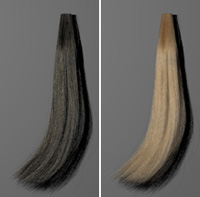High-tech hairdo: New Cornell method gets that natural look in computer-generated blond hair

Marschner lab/Cornell University On the left, a computer-generated image of blond hair with only direct illumination. At right, the same image rendered with the new algorithm that takes into account the multiple scattering of light through the hair. Direct illumination catches the highlights but fails to show the true color. Copyright © Cornell University
Reproducing this effect in computer graphics has always been a challenge. Computers can create three-dimensional structures resembling hair, but the process of “rendering,” in which the computer figures out how light will be reflected from those structures to create an image, requires complex calculations that take into account the scattering between hairs. Current methods use approximations that work well for dark hair and passably for brown, but computer-generated blondes still don't look like they're having more fun.
But now Cornell researchers have developed a new and much quicker method for rendering hair that promises to make blond (and other light-colored) hair more realistic.
Steve Marschner, Cornell assistant professor of computer science, developed the new method with Cornell graduate student Jonathan Moon, who will present the work at the 2006 SIGGRAPH computer graphics conference in Boston July 30 to Aug. 3.
“The model that's been around since the '80s works for black hair, and a model we introduced in 2003 in collaboration with workers at Stanford gets brown hair right and makes blond hair better,” said Marschner, an award-winning computer graphics expert who specializes in making computer graphics more realistic, particularly in animating human beings. “Using that model with our new work provides the first practical method to use physically realistic rendering for blond hair and still get the right color.”
The problem is that light traveling through a mass of blond hair is not only reflected off the surfaces of the hairs, but passes through the hairs and emerges in a diffused form, from there to be reflected and transmitted some more.
The only method that can render this perfectly is “path-tracing,” in which the computer works backward from each pixel of the image, calculating the path of each ray of light back to the original light source. Since this require hours of calculations, computer artists resort to approximations.
“People do something reasonable for one bounce and then assume it reflects diffusely,” Marschner explained. In other words, he said, they assume that hair is opaque. “In light-colored hair it's important to keep track of the hair-to-hair scattering,” he said.
Marschner and Moon's algorithm begins by tracing rays from the light source into the hair, using some approximations of the scattering and producing a map of where photons of light can be found throughout the volume of hair. Then it traces a ray from each pixel of the image to a point in the hair and looks at the map to decide how much light should be available there.
The result, in a test rendering of a swatch of blond hair, appears almost identical to a rendering by the laborious path-tracing method. Path tracing for the test required 60 hours of computation, while the new method took only 2.5 hours, the researchers report.
Marschner now plans to look for better ways to generate the geometric model of hair that underlies the rendering and to simulate realistically the way hair moves. “Tools that generate hair generate random strands in space, and it's unclear whether the arrangement is realistic,” he explained.
Marschner shared a technical achievement award from the Academy of Motion Picture Arts and Sciences in 2004 for a method of rendering translucent materials, including human skin, which helped to make the character of Gollum in the “Lord of the Rings” films more realistic. His earlier methods for rendering hair helped to create computer-animated versions of Naomi Watts in the arms of the computer-animated gorilla in the 2005 version of “King Kong.”
Media Contact
More Information:
http://www.cornell.eduAll latest news from the category: Information Technology
Here you can find a summary of innovations in the fields of information and data processing and up-to-date developments on IT equipment and hardware.
This area covers topics such as IT services, IT architectures, IT management and telecommunications.
Newest articles
Humans vs Machines—Who’s Better at Recognizing Speech?
Are humans or machines better at recognizing speech? A new study shows that in noisy conditions, current automatic speech recognition (ASR) systems achieve remarkable accuracy and sometimes even surpass human…

Not Lost in Translation: AI Increases Sign Language Recognition Accuracy
Additional data can help differentiate subtle gestures, hand positions, facial expressions The Complexity of Sign Languages Sign languages have been developed by nations around the world to fit the local…

Breaking the Ice: Glacier Melting Alters Arctic Fjord Ecosystems
The regions of the Arctic are particularly vulnerable to climate change. However, there is a lack of comprehensive scientific information about the environmental changes there. Researchers from the Helmholtz Center…


